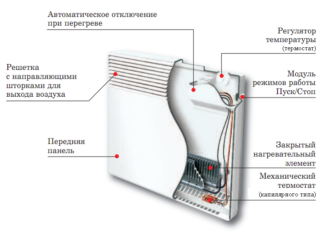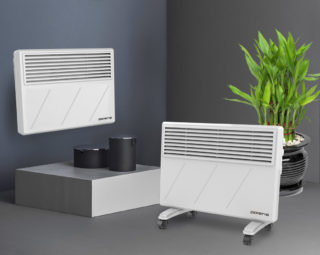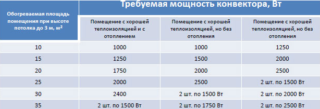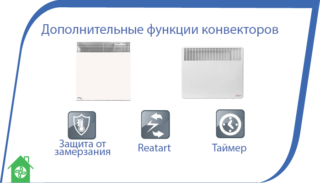A thermal electric convector is an affordable and optimal option for organizing a heating system in a house, apartment, in the country. In order for the home to be well heated, you need to choose a device with parameters and characteristics suitable for the room. You need to be able to calculate the required power of the device, choose a beautiful model, and take into account other nuances of the arrangement.
What is a convector

An electric convector is a device that works from an electrical network and, by heating air masses, heats the room due to the movement of streams of warm and cold air.
The electric convector has the following design: a low-temperature heating coil in a ceramic insulator, placed in a space for heat exchange with surface finning.
According to the standard, the heating circuit of the device is equipped with a step regulator for power control. An alternative could be a thermostat. Such devices help to control the temperature in the room and the amount of energy consumed.
Pros and cons
When planning a heating system, you can go through a lot of options. However, more and more people prefer electric convectors, which are becoming a good alternative to standard heating options.
Before making the final choice, it is worth comparing the characteristics of the heating electric convector with standard options.
| Advantages of electric convection heating of the home | Cons of using this heating option |
| The device is easy to install without disturbing the walls of the rooms. There are several options for installing the fixture. | The device must not be closed or covered, placed next to textile elements - a violation of fire safety rules. |
| Huge selection of models that combine diverse technical and visual characteristics. | The standard type of heating element is a white rectangle or square with openings for hot air outlet. |
| Heats the room quickly and allows you to adjust the air temperature in accordance with the needs and preferences of residents. | A high load may cause a short circuit. It is advisable to install powerful sockets. |
| The device works without noise, convection is carried out gently and smoothly. | It is necessary to periodically check the operation of the device, since everything is connected with electricity. |
| Relatively low cost with a full-fledged home equipment with such devices. | When choosing modern convectors that differ in unique design and technical parameters, the cost of organizing a heating system can become enormous. |
| There is no need to store fuel, specially conduct gas and buy expensive equipment. | If the room needs to be well heated, the waste of electricity will be very large. |
The list goes on, but the rest of the points are insignificant in comparison with those already presented.
Calculation of consumption kW
- Normally, 0.4 kW of heat is consumed for heating 1 m³.
- It is necessary to calculate the volume of the room using special formulas and multiply the result by 0.4.
- The resulting number must be multiplied again by the heat coefficient of the region. Moving from south to north, the number can range from 0.7 to 3 units.
Additional influencing factors can be humidity and home decoration.
Electric convectors rating
In the process of selecting equipment, you need to decide which electric convector is better. Rating according to the VenCon company:
- Atlantic CHG-3 PACK2 DAP;
- ENSTO BETA EPHBE;
- ENSTO BETA mini EPHREM;
- Noirot SPOT E 3 PLUS;
- Cooper & Hunter CH-MC;
The top represents the most effective and functional models from well-known manufacturers.
Possible equipment power
Power is the main characteristic that you should pay attention to when choosing a device. This parameter can be determined by simple calculations: for every 10 m² you need to use 1 kW (ceiling height from 2.5 m to 3.2 m).
Manufacturers offer devices whose power can range from 500 kW to 3000 kW. If the flow rate is slightly different from the heat production, the energy loss will be minimal.
Types of thermostats

The electric heat convector has 2 control options - mechanical and electronic. Each arrangement principle has its own characteristics:
- Mechanical control is provided by means of a relay and a toggle switch. The control system of such a model is not up-to-date and becomes a thing of the past. But climatic technology with a mechanical principle of thermoregulation is in demand due to its low cost.
- Electronic thermostats are more accurate and practical. The control allows you to minimize energy and heat losses. The cost of devices with an electronic control system is high.
Any option for arranging thermoregulation is resistant to voltage drops, which keeps the device working normally.
Equipment safety
Since the convector is a mains-powered device, the following safety rules must be observed:
- Do not act on the housing mechanically.
- Do not place materials that are flammable nearby.
- Position the outlet more than 10 cm from the equipment.
- Do not cover the appliance with a cloth.
- Do not use in rooms with high humidity.
When operating the system, you must adhere to safety rules and remember the general recommendations for the use of electrical appliances.
Convection type
Types of heating elements
An electronic convector can have the following types of heating elements:
- Needle - dielectric plates wrapped in nickel threads.
- Tubular - quartz tube with a heat-conducting insulator inside.
- Monolithic - a filament made of nichrome with a dielectric filling.
- Combined - ten + an element for emitting infrared radiation.
Each type of heating element uses a different amount of electricity.
Mounting method

There are several ways to install climatic equipment, which is determined by the type of model. The equipment can be mounted as follows:
- Floor placement - the equipment stands on wheels or special stands-legs.
- Stationary installation option - the wall-mounted convector is attached to the surface using brackets.
- Universal devices - fixation can be made to the wall or the structure can remain on the floor.
The selection principle is determined by individual preferences and needs.
Equipment design
You can choose a device of any shape, color and size. Usually the body of the fixture is thin and narrow.Often the metal is painted white, but you can find gray, black colors.
Companies are trying to attract new customers not only with technical innovations, but also with specific designs. Therefore, you can find a technique that will fit perfectly into any interior.
Additional functions
- air ionization;
- protection against freezing of the device;
- saving data on the set functions after an emergency shutdown;
- the presence of a thermostat;
- timer to control the operating time;
- the function of switching the speeds of the heating elements;
- display for control and setting functions;
- moisture protection;
- remote control using the remote control;
- air purification;
- additional infrared radiation;
- Motion Sensor.
Additional functions can be activated automatically or adjusted by means of buttons, display.
How to choose convectors for heating a summer cottage
The summer cottage is a place where people usually visit in the summer, so you should not choose complex heating options for the winter. An ideal example would be a household electric convector:
- It is better to buy a universal model according to the type of installation.
- It is advisable to install equipment that is equipped with motion sensors and electronic control.
- It is not necessary to heat the whole house, so it is worth choosing specimens with low power.
It is worth considering the peculiarities of the dwelling - the area of the glazed zones, the degree of wall insulation, the presence of additional heat sources.
Convector-type climatic technology becomes relevant in comparison with outdated options for heating a home due to progressive principles of arrangement. There is a huge variety of models that have diverse technical characteristics and parameters. When choosing, it is worth considering the power of the device, the type of convection and appearance.











